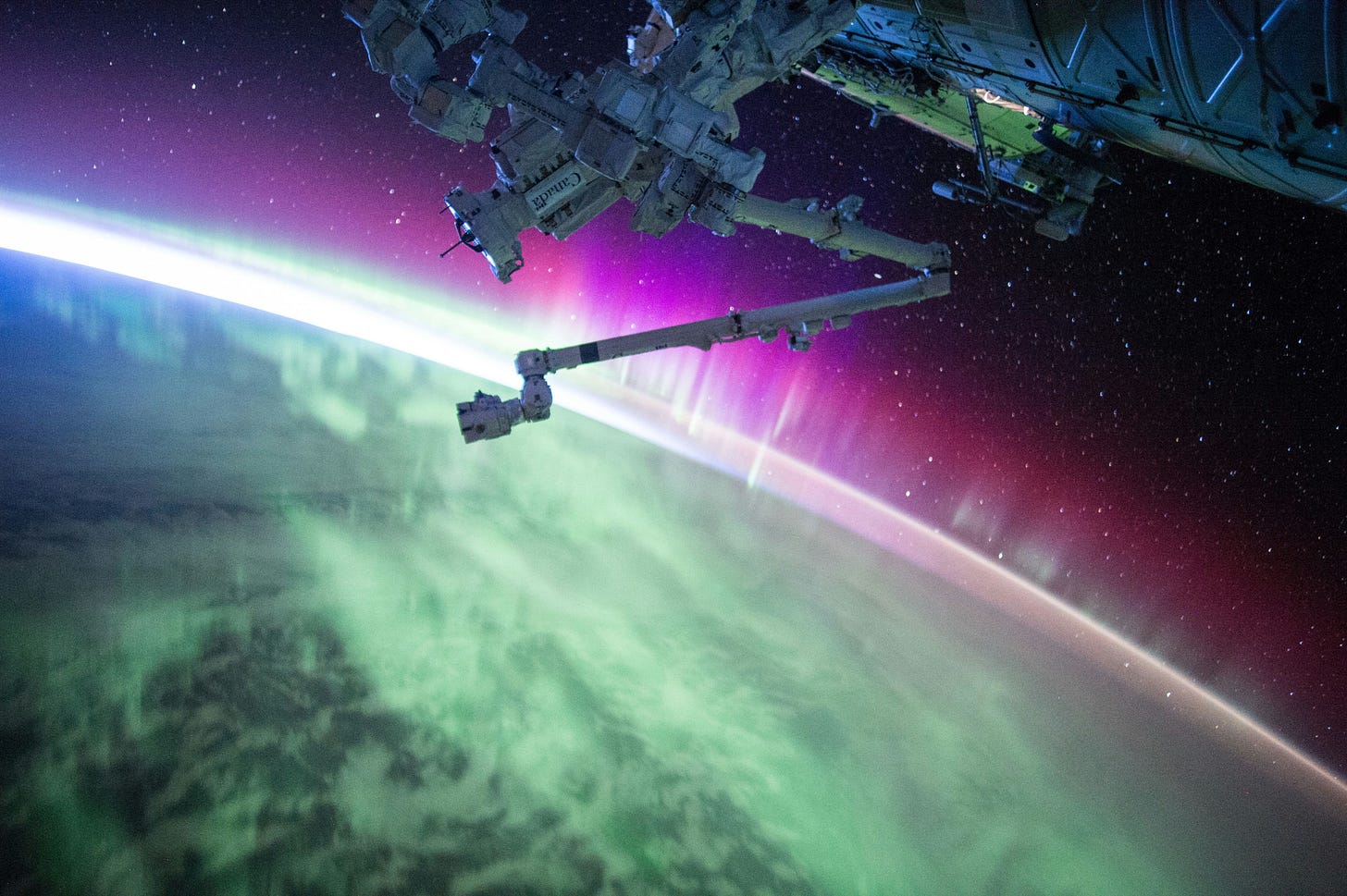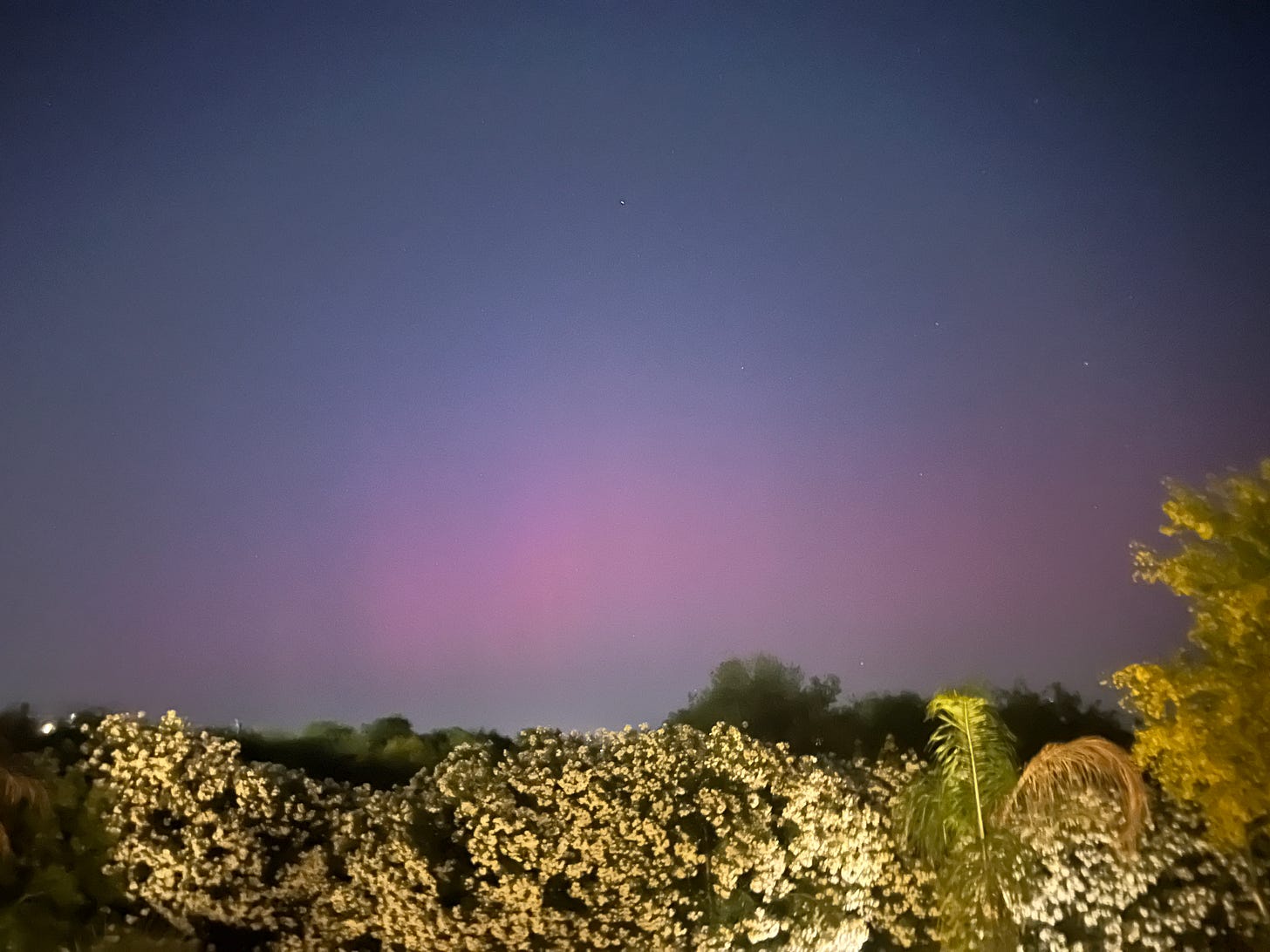The following is a free post. If you want access to our comment box & community, subscribers-only posts, and future subscribers-only features, you can grab all of that for just $8 a month (or even less on an annual plan) by subscribing right here:
Writing is how I make my living, so if you like what you see here, please support my work by subscribing!
If you’ve already subscribed but would like to buy me a coffee to help keep me fueled up for writing, you can do that here:
I was really excited earlier this year when I heard that it might be possible to see the Aurora Borealis from Arizona during one of the big solar storms.
I went out on my upstairs balcony and looked North.
And I saw bupkis.
My phone, however, caught something. A hint of purple at the bottom of the screen.
I thought it was pretty wild that I could see even that much, with a camera, all the way down in Phoenix.
Last week, the Aurora was rumored to be heading south again. Now that I’m in North Carolina, I thought for sure I had a better chance of seeing it. I went out, got in the Jeep, drove outside our little neighborhood to some backroads with no street lights, out near some local farms, and I somehow got even less than in Phoenix:
Just the faintest little hint of purple or pink. But then I looked online, and I saw people posting incredible photos, from as far south as Florida!
Look at this:
I figured maybe I just got the timing wrong. I thought it was a whole-evening kind of event, but perhaps I went out too late?
Still, I was excited, because if they could see it in Florida, that meant, in my mind, that with sufficiently strong solar activity, it would probably happen again.
But I didn’t understand why the Aurora was appearing so far south. And then I came across a tweet from Ben Davidson, founder of Space Weather News:
I was wary this was a rabbit hole, but the video was only three minutes long. So I watched, and holy cow, I did not know any of this:
Here’s a partial transcript:
Hey everyone, it was really great to see so many posts about the Aurora this week. It’s awesome that you guys got to see it, and for many of you, it was the second time this year after basically never having seen them before. But not too many people are asking why, all of a sudden, are we seeing them so often?
Well, you may have heard that it is Sunspot Maximum, and that’s true, but that happens every 11 years. Yes, we had a solar flare release a CME at Earth, but that has happened hundreds of times in just the last decade. This one was big, but not that big. So why have we had these auroral sightings this year, now, when much bigger events have hit us in the past and went largely unnoticed?
Well, apart from the solar activity, the main factor in the production of Aurora is Earth's magnetic field, and it has been weakening. You may have heard we are in the beginning stages of a magnetic pole shift—a rapid one. The magnetic poles are moving, and the overall magnetic protection of our Earth is fading, which is why these recent solar events are producing much more Aurora than would normally be expected. These magnetic pole shifts are also called geomagnetic excursions, and they happen cyclically on our planet.
Davidson goes on to explain that roughly every 6,000 years, the Earth experiences a magnetic pole shift. And it’s happening again right now, though most people have no idea. This one is expected to peak in its effects in the year 2040.
And, Davidson warns, this is going to cause significant problems:
Now, if it was just about pretty lights in the sky, I would say, “Who cares?” But it’s not. During these events, the weaker magnetic field of Earth allows extra ozone depletion, changes the jet streams, allows more cosmic radiation to enter the atmosphere, and disrupts animal navigation that relies on Earth's magnetic field. That’s why studies identify these magnetic shifts as being extremely dangerous, extinction-inducing events for many species.
And now, on top of all of that, humans have an electrified way of life we rely on, and that’s at greater risk due to solar activity as well. Imagine that while the atmosphere is changing, radiation is surging, and the food chain is taking hits like Jenga, we lose power, heating, water purification, and distribution. No internet, no cell phones, no banks, no ATMs, no gas stations, no refrigeration of food. That’s why this matters.
As we said, it is due in time. Right now, in the cycle, it has already begun, and we’re seeing the early signs that our planet is in a “shields down” situation with these above-average auroral sightings.
So if Davidson is right, what can we expect to happen? I asked ChatGPT for a rundown of the effects, and everything it tells me tracks with what Davidson is warning about:
1. Increased Cosmic and Solar Radiation
Radiation Exposure: As Earth's magnetic field weakens, more cosmic and solar radiation can penetrate the atmosphere, increasing the risk of radiation exposure on Earth's surface. This can lead to higher rates of cancer and other radiation-related illnesses, especially for people living at higher altitudes and near the poles, where the magnetic field is weaker.
Impact on Aviation: Airline passengers and crews flying at high altitudes and near the poles could face increased radiation exposure. This is particularly concerning for long-haul flights and polar routes, where exposure to cosmic rays is already higher.
Astronauts and Satellites: Increased radiation could also pose a greater risk to astronauts in space and satellites in low-Earth orbit, which rely on Earth's magnetic field for protection. Space missions might need additional shielding or adjustments in orbits to avoid the most intense radiation zones.
2. Disruption to Electrical Grids and Technology
Geomagnetic Storms: Weakened magnetic field conditions make the Earth more vulnerable to geomagnetic storms. These storms, triggered by solar flares or coronal mass ejections (CMEs), can induce electric currents in power lines and transformers, potentially leading to widespread power outages, damage to electrical infrastructure, and even long-term grid failures.
Satellite Damage and Communication Disruptions: Increased solar activity can disrupt satellite communication, GPS signals, and other technologies dependent on stable electromagnetic conditions. Satellites could experience degradation or failures due to enhanced radiation exposure and geomagnetic fluctuations.
Internet and Communications: A geomagnetic storm could knock out global communication systems, disrupt the internet, and interfere with underwater cables that transmit data between continents. Financial institutions, businesses, and governments that rely on internet and satellite communications could face major disruptions.
3. Ozone Depletion and Climate Impacts
Ozone Layer Weakening: With more cosmic rays and solar radiation reaching the stratosphere, Earth's ozone layer could become more vulnerable to depletion. The ozone layer protects life on Earth by absorbing harmful ultraviolet (UV) radiation. Ozone depletion could lead to higher levels of UV radiation reaching the surface, which increases risks for skin cancer, cataracts, and other health issues, as well as damaging ecosystems.
Jet Stream Changes: The weakening of the magnetic field might also influence atmospheric patterns, particularly the jet streams. Disruption of the jet streams could lead to more erratic weather patterns, contributing to extreme weather events such as stronger storms, prolonged droughts, or shifts in seasonal weather patterns.
4. Animal Navigation Disruption
Animal Migration and Behavior: Many animals, including birds, sea turtles, bees, and whales, use Earth's magnetic field for navigation. A weakening or shifting magnetic field could disrupt their migratory patterns, leading to increased disorientation, changes in migration timing, or even species displacement. This could have broader ecological effects, particularly in marine and avian ecosystems.
Mass Strandings: There could be an increase in the number of mass strandings of whales and other marine animals, as they rely heavily on magnetic cues for migration and navigation.
5. Global Weather Shifts and Extreme Events
Climatic Instability: Geomagnetic excursions have historically coincided with periods of climatic instability. We might see shifts in global climate patterns, with more unpredictable weather, extremes of temperature, and potential disruptions to agriculture and food production. There are studies suggesting that geomagnetic shifts could influence changes in the atmosphere's circulation patterns, contributing to altered weather conditions.
Solar Activity Amplification: Increased solar activity could result in more intense solar flares and CMEs, leading to heightened geomagnetic storms. These storms could further affect global weather patterns, potentially worsening the impact of storms, hurricanes, or other severe weather phenomena.
6. Impact on Human Infrastructure
GPS and Navigation Systems: Disruptions in Earth's magnetic field could affect navigational systems that rely on magnetic compasses, especially in critical fields like aviation, maritime shipping, and military operations. Systems that depend on precise GPS signals could be impacted by geomagnetic disturbances.
Power and Water Supply: In the event of a major solar storm coupled with a weakened magnetic field, power grids could fail, disrupting electricity supplies for extended periods. This would affect water purification and distribution systems, healthcare services, transportation, food refrigeration, and communication infrastructures. The effects could ripple across modern infrastructure, leading to significant societal disruptions.
7. Extinction-Level Threats (Hypothetical)
While geomagnetic excursions alone are not typically considered direct extinction-level events, they have been correlated with significant environmental stressors and mass extinction events in Earth's history. Increased radiation exposure and climate instability during these periods could have contributed to species die-offs in the past.
Some scientists speculate that combined stress from weakened magnetic protection, higher radiation levels, disrupted ecosystems, and human reliance on vulnerable infrastructure could create long-term challenges for humanity if we are not adequately prepared.
8. Psychological and Social Effects
Increased Anxiety and Panic: As geomagnetic storms and other phenomena become more frequent, we might see increased public anxiety or panic, especially if significant technological disruptions occur. The unpredictability of geomagnetic events, along with their wide-ranging consequences, could fuel concern about the stability of modern life.
Global Responses: Governments and scientists would likely intensify efforts to study and mitigate the impacts of these geomagnetic changes, potentially leading to new technologies for grid protection, satellite shielding, and animal navigation support. There might also be more international cooperation to safeguard power grids, communications, and other critical infrastructure.
It has not yet been scientifically proven that human beings could perceive these magnetic field changes, but there is evidence suggestive of the fact that this may be possible. Human beings have complex electro-chemical processes that could potentially be thrown off by these disruptions. ChatGPT tells me that both moods and mental health could be affected by electromagnetic sensitivity:
Mood and Mental Health: There is some research suggesting that geomagnetic storms and increased solar activity can influence human behavior, mood, and even mental health. Studies have found correlations between geomagnetic disturbances and higher rates of depression, anxiety, and even suicidality, though the mechanisms behind this are not fully understood. Some theories suggest that increased cosmic radiation or changes in Earth's electromagnetic environment during geomagnetic storms might interfere with biological processes, such as melatonin production, or disrupt circadian rhythms.
Electromagnetic Sensitivity: Some individuals claim to experience symptoms like headaches, fatigue, irritability, and dizziness during periods of heightened electromagnetic activity, a phenomenon sometimes referred to as electromagnetic hypersensitivity (EHS). While EHS remains controversial and not officially recognized as a medical condition, it’s possible that some people might be more sensitive to fluctuations in Earth’s magnetic field.
This is of particular interest to me, since I have been noticing that something feels “off,” and when I asked my followers on X, many of them replied that they feel the same way.
Now, this could just as easily be the supercharged political climate and division in the country, or any number of other environmental factors.
But the more woo I become, the more I have come to suspect that things like this actually have profound effects on us. At a fundamental level, we are energy beings.
I also wonder if this is partially the reason why we’re seeing this worsening in our storms. As I said the other day about climate change, it’s happening, but I don’t believe we have enough data to conclusively know the why of it.
This is definitely a developing situation I’ll be keeping an eye on.









